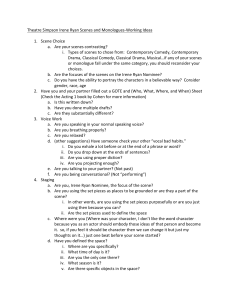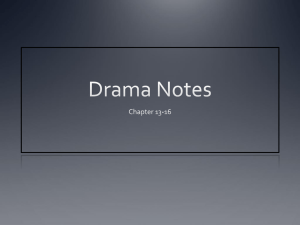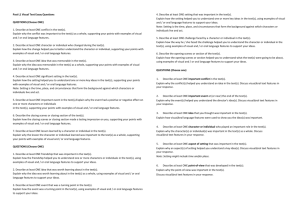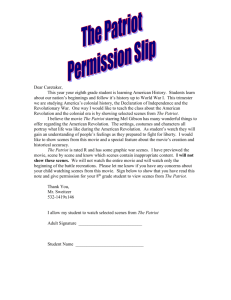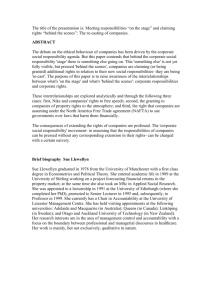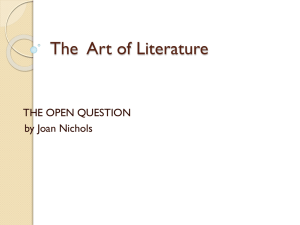Highway Attitudes and Levels of Roadside Maintenance 1
advertisement
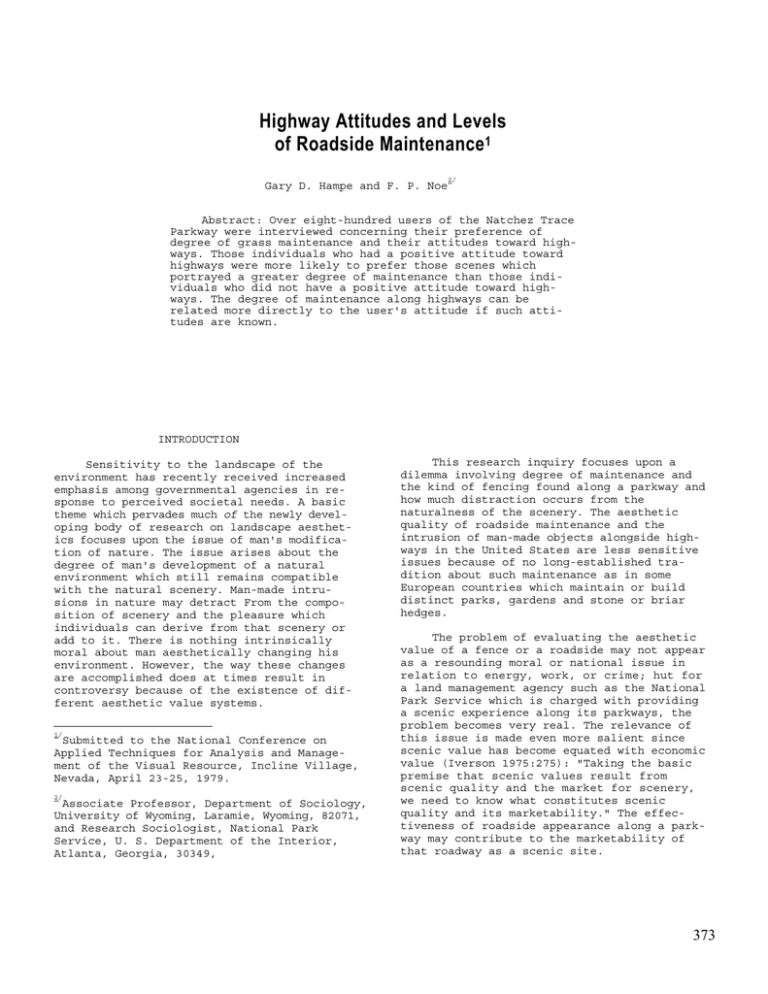
Highway Attitudes and Levels of Roadside Maintenance1 Gary D. Hampe and F. P. Noe 2/ Abstract: Over eight-hundred users of the Natchez Trace Parkway were interviewed concerning their preference of degree of grass maintenance and their attitudes toward highways. Those individuals who had a positive attitude toward highways were more likely to prefer those scenes which portrayed a greater degree of maintenance than those individuals who did not have a positive attitude toward highways. The degree of maintenance along highways can be related more directly to the user's attitude if such attitudes are known. INTRODUCTION Sensitivity to the landscape of the environment has recently received increased emphasis among governmental agencies in response to perceived societal needs. A basic theme which pervades much of the newly developing body of research on landscape aesthetics focuses upon the issue of man's modification of nature. The issue arises about the degree of man's development of a natural environment which still remains compatible with the natural scenery. Man-made intrusions in nature may detract From the composition of scenery and the pleasure which individuals can derive from that scenery or add to it. There is nothing intrinsically moral about man aesthetically changing his environment. However, the way these changes are accomplished does at times result in controversy because of the existence of different aesthetic value systems. 1/ Submitted to the National Conference on Applied Techniques for Analysis and Management of the Visual Resource, Incline Village, Nevada, April 23-25, 1979. 2/ Associate Professor, Department of Sociology, University of Wyoming, Laramie, Wyoming, 82071, and Research Sociologist, National Park Service, U. S. Department of the Interior, Atlanta, Georgia, 30349, This research inquiry focuses upon a dilemma involving degree of maintenance and the kind of fencing found along a parkway and how much distraction occurs from the naturalness of the scenery. The aesthetic quality of roadside maintenance and the intrusion of man-made objects alongside highways in the United States are less sensitive issues because of no long-established tradition about such maintenance as in some European countries which maintain or build distinct parks, gardens and stone or briar hedges. The problem of evaluating the aesthetic value of a fence or a roadside may not appear as a resounding moral or national issue in relation to energy, work, or crime; hut for a land management agency such as the National Park Service which is charged with providing a scenic experience along its parkways, the problem becomes very real. The relevance of this issue is made even more salient since scenic value has become equated with economic value (Iverson 1975:275): "Taking the basic premise that scenic values result from scenic quality and the market for scenery, we need to know what constitutes scenic quality and its marketability." The effectiveness of roadside appearance along a parkway may contribute to the marketability of that roadway as a scenic site. 373 PREVIOUS RESEARCH Previous analysis into the value of nature in outdoor environments was reported by Moeller (1974:6) who indicated that the "natural environment, taken as a wholistic entity, is viewed favorably by all recreationists." Irrespective of how the natural environment is pictured, whether as lake, mountain or forest, the view was appreciated as pleasing to the recreationist despite the wide variety of activities pursued in the outdoors. The propensity among viewers was towards naturalistic scenes where "landscapes were predominantly natural or consisted of natural materials such as in agricultural areas" (Zube et al. 1975:154). Scenes pertaining to nature were also anthropomorphized by describing physical phenomena in which "behavioral terms" or "unexpected sensory attributes" such as "peaceful," "quiet," or "desolate" indicated but a few of the kinds of connotations used to identify sites (Gunn, 1976:23). At best, the pervasiveness of nature or signs of naturalism are apparently highly valued as meaningful perceptual phenomena or strongly identified with man. constitutes a man-made development, we anticipated that there would be preferential differences among choices of selected scenes that were more natural as opposed to those scenes that appeared less natural in relation to the surroundings. Social factors help induce man toward increasing his preferences of concern for outdoor landscapes which very often include fences. The results of a study by Carls (1974:122) strongly indicate that "numbers of people and level of development have a noticeable effect on a preference for outdoor recreation landscapes." The level of preference for a landscape is reduced as the presence of individuals increases and as higher levels of development take place on particular sites. The relationship between a natural environment and preferences is not directly attributable to an immutable value orientation but varies considerably among individuals and site conditions. An obvious area of exploration has centered upon motives for utilization of the environment. "Motivation and purpose in the environment influence perception. This motivation is significant because what an individual attends to in an environment depends on his purpose" (Haskett 1975:6-7). Data for this study were collected in July 1977, October 1977, and April 1978. On each occasion, interviews were conducted on a Friday and the following Saturday. Three interview sites used for all interviews were the Ridgeland Information Center, Mississippi, Jeff Busby State Park, Mississippi, and Colbert State Park, Alabama. These sites represent locations on the Natchez Trace Parkway from the southwest section to the northeast section of the Parkway. THE PROBLEM The evaluation of motivations for traveling along the parkway, recreational involvement, and attitudinal behaviors reflecting roadside attitudes was included in the analysis in order To determine differential preferences for degree of maintenance along the parkway. Since roadside maintenance 374 Not only had previous studies indicated that natural scenes were highly desirable but the man-made artifacts appearing in naturalistic scenes were reported as negatively detracting from their value (Hampe 1973:43, Zube 1973). Gross as well as subtle comparisons between natural as opposed to developed lands have been reported that indicate that when man-made objects appear in a natural scene, the result is a downgrading of the scene (Linton 1968). The question remains which type of scene will be preferred when individuals are presented the choice between similar scenes with some that are more natural as opposed to those exhibiting more man-madeness in design. METHODS Motor vehicles were stopped at random every twenty minutes until the number stopped equaled the number of interviewers at the site. If by chance a vehicle had been stopped at another site, it was not included in the study a second time. Each interviewer had a list of random numbers for determining which individual over 15 years of age, (the age at which an individual could legally drive) within a vehicle would be interviewed. Because the arrival of vehicles at a particular site is random and because the random numbers were used in selecting the interviewee, it is felt that a simple random sample of the vehicles and passengers traveling the Natchez Trace Parkway on a Friday and Saturday was collected. The refusal rate was approximately 5 to 40 percent depending upon the time of day. The respondents were shown three sets of scenes which were taken along the Parkway. R F Figure 1 Maintenance Scenes H W G 375 differences were found for the most highly preferred and maintained scene--F. Individuals who agreed with the "billboard" attitude were more likely to rank scenes R and C first rather than last and were also more significantly likely to rank Scene H last rather than first. The relationships in Table 1 were controlled for the effects of residence within the East South central (Mississippi, Alabama and Tennessee) region of the U.S. as compared to other regions of the U.S. The relationships remained in the same direction for those individuals living in the South but no real relationships were observable for those living outside the region, except for Scene W where those who agree with the "billboard" item were significantly more of variance. The differences within the scenes using both methods were statistically significant at P < .001. The focus of this analysis is not upon the overall order of the ranking of the scenes per se, but upon the extent of the influence of highway attitudes on the preference for the individual scenes. Grass Maintenance Scenes and Highway Attitudes Statistically significant relationships between the ranking of a scene and agreeing that billboards make a trip more interesting ("billboard") were found for three of the grass maintenance scenes (See Table 1). No Table 1--Attitudes Toward Billboards by Grass Maintenance Scenes Controlled by Region of U. S. Where Respondent Resides (Percent who agree billboards make a trip more interesting) Rank of Scene Total Sample F R 1/ 1 2-4 5 2 X τ 35.3 (464) 40.8 (306) 23.5 (34) 2/ 5.140 -.026 1 2-4 5 2 X • 39.0 (395) 43.3 (251) 25.0 (24) 3.635 -.018 1 2-4 5 2 X • 10.8 (65) 24.0 (50) 20.0 (10) 3.618 -.120 44.9 (176) 34.9 (599) 31.0 (29) 6.284* .074 C W 44.4 (54) 26.9 (52) 37.9 (646) 36.7 (602) 26.9 (104) 41.3 (150) 6.055* 3.496 .066* -.052 East South Central U.S. 48.6 (140) 45.8 (48) 30.9 (42) 38.2 (505) 41.0 (541) 40.6 (488) 32.0 (25) 30.9 (81) 41.5 (130) 5.607 3.728 1.618 .077* .056* -.029 All Other Regions of U.S. 25.0 (32) 33.3 (6) 0.0 (9) 13.5 (89) 17.5 (97) 15.2 (99) 25.0 (4) 9.1 (22) 35.3 (125) 2.432 2.145 6.170* .073 .078 .135* H 22.8 (57) 36.1 (277) 39.2 (470) 5.956* -.064* 21.4 (42) 38.8 (232) 42.9 (346) 7.576* -.081* 26.7 (15) 17.1 (41) 14.5 (69) 1.309 .066 1/ The percentage to the left of the number in the parentheses indicates the proportion of individuals who fall into that particular category. In this case 35.3 percent of those individuals who ranked Scene F as first (N = 464) agreed that billboards make a trip more interesting as compared to 23.5 percent of those who ranked Scene F as last (N = 34) who thought billboards make a trip more interesting. This method of presenting the data is followed in this table and throughout any other table unless specified otherwise. 2/ 2 X is the chi square statistic, while • is Tau C. An '*' following the chi square statistic and/or the Tau is to indicate that the statistic is significant at P ≤ .05. 376 The first set consisted of grass maintenance scenes, the second set was fence scenes and the third set was of general scenes of the Parkway. Each set consisted of five scenes which were 5" x 7" color photographs of consistent quality. Each of the three sets of scenes was mounted on a large white art board so that the respondent could compare within each set and rank the 5 scenes from first to fifth. This analysis is concerned only with the maintenance scenes. Over 800 respondents were able to do this for all three types of scenes except for a few who had difficulty with the grass maintenance scenes. Measures of the Independent Variable Two questions were used in the interview schedule to determine the attitudes the respondents felt toward a highway or roadway. The respondents were classified as having a high road orientation if they agreed with the statement: Most billboards help to make a trip more interesting, or if they disagreed with the following statement: Most of the man-made objects found along roadsides arc eyesores. The analysis is concerned with the relationship of these two attitudes and choice of maintenance scenes. The Dependent Variable The dependent variable was each grass maintenance scene of which there were five, representing varying degree of maintenance (See Figure 1).The most maintained scene was F having the grass cut up and around the trees; next most maintained was R, with the grass cut up to the tree line; then came G, with the grass cut to the swale of the ditch; then fourth in terms of maintenance was H, with one mower swath done alongside the highway; and last in maintenance was W, where no grass had been cut at all. Hypothesis We hypothesized that individuals who possessed a high road orientation would prefer roadside scenes which indicated a higher degree of maintenance as measured by grass levels. This belief that if one possessed a highroad orientation, this would affect the choice of scenes along a parkway was based on the premise that "landscape elements are physical features of the environment that are either naturalistic, man-made, or exhibiting both natural and man-made characteristics." (Haskett 1975:2). The range of landscape elements can be expressed as a continuum between the extremes of purely natural and entirely man-made features. The distinction is rather simplistic but useful in that it does identify the limits of norms within which a more meaningful context for evaluating such items as grass maintenance. Type of Analysis The relationships between the ranking of each scene and the two highway attitudes were analyzed by using the chi square statistic for the test of significance and Tauc for a measure of association. Each relationship was controlled for background factors such as age, education, sex, socioeconomic status, etc. No real difference was found on the zero-order relationship by these variables. Control variables dealt with reasons for using the Parkway and other related background factors. The results are presented for the zero-order relationship between highway attitudes and the rank of scenes controlled by region of the U.S. where the respondent resides. This variable was highly associated with factors such as region of U.S. where raised, reason for using the Parkway, frequency of use and distance driven on the Parkway. Region of U.S. was the most important control variable in that it included the effects of those other variables. RESULTS Rank of Scenes The order of preference from first to last of the grass maintenance scenes was F, 3/ R, G, W and H, respectively. The ranking of the scenes was examined using one-way analysis of variance and also Kruskal-Wallis analysis 3/ The means are F (1.782), R (2.238), G (3.128), W (3.647) and H (4.144), where a mean of 1 would indicate the scene was chosen first and a mean of 5 would indicate that the scene was chosen last. 377 some which are quite similar to one another, on a continuum from most preferred to least preferred. All these scenes showed the effects of maintenance or lack of it in some way. Secondly, individuals with different attitudes will rank these scenes somewhat differently-in this case the attitudes examined were attitudes toward highways and their roadsides. Third, and perhaps most important for planners concerned with highways, the degree of maintenance preferred along a highway can vary considerably given the attitudes of those who use them. This means if one knows the attitudes of the average user, adjustments can be made accordingly in the degree of mainte-nance or in the changing of the attitudes themselves. Last, the results presented here are only a partial analysis of the kind of reasons why individuals rank scenes along a highway the way they do. likely to rank this scene last of all. The relationship between the choice of maintenance scenes and disagreeing with the item that stated most man-made objects along a roadside are eyesores ("eyesore") was statistically significant for Scenes G and H, the third and fifth ranked scenes overall for the total sample (See Table 2). The relationship within Scene C and H showed the same relationship as discussed concerning the "billboard" item. Those with a positive highway attitude ranked Scene G first more than last and ranked Scene H last more than first. When controlled for region of the country, the relationship was significant for those who lived within the South, but not for those outside the region, although the direction of the relationship was the same as found at the zero-order level. Table 2--Attitudes Toward Roadside Objects by Preferred Grass Maintenance Scenes Controlled by Region of U.S. Where Respondent Resides (Percent who disagreed that most man-made objects along a roadside are eyesores) Rank of Scene Total Sample F 1 2-4 5 2 X τ 50.1 (464) 49.4 (306) 32.4 (34) 3.826 .030 1 2-4 5 2 X • 50.8 (388) 48.8 (250) 37.5 (24) 1.682 .035 1 2-4 5 2 X • 30.0 (60) 46.9 (49) 20.0 (10) 4.585 -.086 R 54.0 (176) 46.9 (599) 55.2 (29) 3.213 .037 W 51.8 (54) 39.2 (51) 50.8 (646) 48.5 (602) 34.6 (104) 53.0 (151) 9.583* 2.951 .075* -.049 East South Central U.S. 55.0 (140) 45.8 (48) 37.5 (40) 47.8 (498) 41.0 (541) 49.3 (493) 54.2 (25) 30.9 (81) 54.3 (129) 2.484 3.728 3.483 .039 .056* -.058* All Other Regions of U.S. 46.9 (32) 33.3 (6) 25.0 (8) 31.3 (83) 17.5 (97) 37.2 (94) 50.0 (4) 9.1 (22) 35.3 (17) 2.764 2.145 0.484* .094 .078 -.109* SUMMARY AND SUGGESTIONS The main research finding was that having a positive attitude toward billboards and believing that not all objects along the roadside are eyesores did have an influence upon the aesthetic interpretation of a scene. Such individuals were more likely to rank first those scenes which were neater in appearance and showed the efforts of maintenance. Several- implications can be drawn from this research. First, individuals can quite easily rank highway or roadside scenes, 378 C H 31.0 (58) 48.4 (277) 51.2 (469) 8.402* -.073* 30.2 (43) 50.0 (228) 51.4 (391) 6.976* -.062* 33.3 (15) 28.2 (39) 41.5 (65) 1.936 -.109 LITERATURE CITED Carts, E. Glenn 1974. The Effects of People and Man-Induced Conditions on Preferences of Outdoor Recreation Landscapes. Journal of Leisure Research 6:113-124. Dunn, Michael C. 1976.Landscape with Photographs: Testing the Preference Approach to Landscape Evaluation. Journal of Environmental Management 4:15-26. Hampe, Gary D. with Verne Smith and Jim Mitchell 1973. Water-Related Aesthetic Preferences of Wyoming Residents. Water Resources Series No. 46. Water Resources Research Institute, University of Wyoming. Moeller, George, Robert MacLachlan, and Douglas A. Morrison 1974. Measuring Perception of Elements in Outdoor Environments. USDA Forest Service Research Paper NE/289. Haskett, Sarah 1975. Evaluating Visual Quality of the Coast Line: Some Significant Issues. Working Paper No. 2. Reprinted by the New York Sea Grant Institute, Albany, New York. Tilden, Freeman 1976.Who Am I? Inside Interior 10:3. Iverson, Wayne 1975. Assessing Landscape Resources: A Proposed Model. Pp. in E. H. Zube, Robert O. Bush, and Julius Fabis (eds.), Landscape Assessment: Values, Perceptions, and Resources. Stroudsburg, Penn." Dowden, Hutchinson and Ross, Inc. Linton, D. L. 1968. "The Assessment of Scenery as the Natural Resource." Scottish Geographical Magazine 64:219-238. Zube, Ervin H. 1973.Rating Everyday Rural Landscapes of the Northeastern U.S. Landscape Architecture July:371-375. Zube, Ervin H., David G. Pitt, and Thomas W. Anderson 1975.Perception and Prediction of Scenic Resource Values of the Northeast. Pp. 151-167 in E. H. Zube, Robert O. Bush, and Julius Fabos (eds.), Landscape Assessment: Values, Perceptions, and Resources. Stroudsburg, Penn." Dowden, Hutchinson and Ross, Inc. 379

